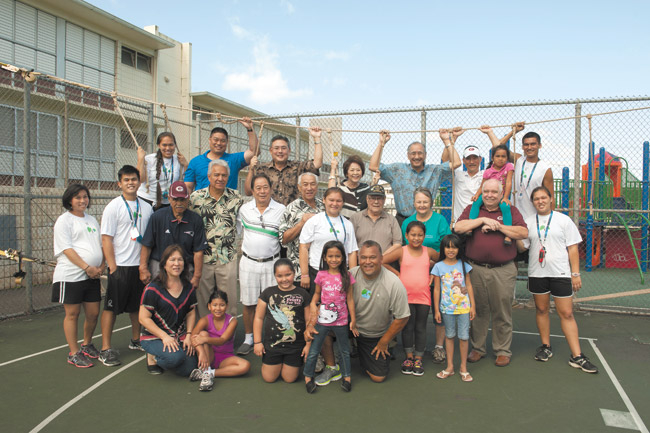A Postcard From KAMP
Aaron Kamau grew up in Kalihi and knows the risks youth face. In response he created KAMP, which promotes teamwork while giving kids confidence in their own abilities. Teachers say the results are amazing.
With newspapers filled with stories about new Common Core standards, Race to the Top funds and teacher evaluations, we often get lost in the mission we all have as parents and educators: to raise quality human beings.
mw-cover-070914-kamp-1
Aaron Kamau (center) grew up in Kalihi and knows the risks youth face. In response he created KAMP, which promotes teamwork while giving kids confidence in their own abilities. Teachers say the results are amazing.
Row 1 Michele Kamau, Paula Telles, Gabby Maualaivao, Kauanani Mailou, Aaron Kamau, Hailey Faleunga, Grichelle Domingo Row 2 Stephanie Aiona, Aaron Kamau, Jr., George Kamau, Elroy Chong, Eddie Hayashi, Danny Kaleikini, Brittany Kamau, Joseph Vierra, Jr., Sharon Souza, Bert Carter, Mary Kamau Row 3 Ashley Kamau, David Pila, Glenn Goya, Linda Wong, Tyler Tokioka, Randall Okimoto, Shayna-lyn Mailou-Miller, Ben Kamau | Nathalie Walker photo nwalker@midweek.com
All the books, technology and classroom time in the world do not ensure that happens; it takes us caring about kids and showing them the way. But what about the kids in tough situations not of their own making, the ones who have no one to turn to but our baser elements and easier roads?
These are the ones at the heart of the founding of KAMP (Kids At Risk Mentoring Program) Hawaii.
Started in the living room of Aaron and Michele Kamau, they wanted to find a way to help at-risk kids and arm them with the power of confidence and the ability to work with others.
Drawing from his two decades of experience working with Boy Scouts of America, Kamau formed an outdoor activity experience that shapes the interior of their minds and hearts.
A born-and-raised Kalihi boy, Kamau grew up surrounded by hard situations and broken families, but was raised by his father not to be scared of it, but acknowledge and help those individuals.
“My dad George Kamau is my greatest supporter as a person who has helped me form a solid base for life,” says Kamau, who also works as a track and football coach at Farrington High. “My upbringing has a huge influence on how I operate KAMP Hawaii today. He would encourage me to take care of the people who reach out to me and to never take anything for granted. Never run from adversity, just face it head on and resolve it.”
Every summer KAMP runs day camps at different parks around the island from Kahuku to Waimanalo to Waianae. The camps are staffed by 30 youth mentors hired straight out of Farrington.
“Total buy-in from the kids, right out of the projects, but they are good students and they are put into the fire right away,” says Kamau. “They are working with 45 kids for 45 minutes and they have to incorporate everything, drive the nail in and keep it fun.”
The camps generally have six activity areas staffed by these fresh graduates, who bring lessons about bullying, drugs and gangs, and correlate them with the games and challenges they have, such as Human Ladder and Kalo Bridge Crossing. They are reaching almost 9,000 kids a year currently, and with more funding — they recently received a grant from NFL Foundation in conjunction with the 2014 Pro Bowl — hope to raise that number each year.
These summers also serve as a training ground for these graduates to give them life skills and confidence in handling groups of people who are invaluable to any of us, but especially to these teens either entering the work force for the first time or preparing for the grind of college.
Even though his roots are in the rougher edges of our Island home, Kamau sees needs in all our schools.
“To us, every kid is at-risk,” he says. “After years of working with the DOE, now they call us and we go there and provide once-a-week programs where we can.”
Their programs are currently serving 66 schools on Oahu, either a 13 or 27-week course that is run during the school day and brings those same messages and physical challenges to younger students. These have become some of the kids’ favorite part of the week and have helped reach those who sometimes struggle with the traditional school environment.
“I have seen students who have behavioral problems in the classroom, but when KAMP comes in every week, they are the ones who shine because they have a chance to get up and move around and be involved in more activities,” says Renee Hirano, fifth-grade teacher at Jefferson Elementary.
Sometimes it is something as simple as building “hobo stoves” and cooking their own bacon and egg sandwich that enables the kids to see that they are empowered and can accomplish goals.
The five main components they emphasize are team building, leadership, decision-making, communication and cooperation, many of which are hard to conceptualize in the rush of a school day.
“They have an activity, talk about the activity and reflect on it,” says Sharon Souza, a special education teacher in Aina Haina who has been involved with KAMP since its founding in 2005.
“Kids around 9 and 10, especially competitive boys, are not good at teamwork. They all want to be the leaders, and they want everyone to do what they want to do. They learned that it is a life skill being able to work with other people cooperatively on a team. They were used to a team with coaches that tell you what to do, then you go do it. In this, they have a problem, they have to figure it out and work together on a solution.”







